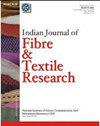用异丙醇钛处理涤纶织物制备CO2吸附织物
IF 0.6
4区 工程技术
Q4 MATERIALS SCIENCE, TEXTILES
引用次数: 0
摘要
在涤纶床罩织物表面涂覆二氧化钛,制成了一种新型织物,可以吸收环境中的二氧化碳。通过FTIR、EDX和SEM对产物进行了表征。研究了钛加入量和温度等参数,确定了最大CO2吸收量,最终设定为6 mL钛源/L和130℃(% 95 ram)。同时,还进行了各种测试,如织物的起球、磨损和耐久性。这样生产的织物样品也要通过认可实验室进行的刺激性测试。本文章由计算机程序翻译,如有差异,请以英文原文为准。
Preparation of CO2 adsorbing polyester fabric by treating it with titanium isopropyl alcohol
Novel fabric that will absorb CO2 in the environment has been produced by coating TiO2 on the fabric surface of apolyester bedspread. The products are characterized by FTIR, EDX and SEM analyses. The parameters, such as the amountof titanium added to the bath and the temperature, are studied to specify maximum CO2 absorption, which ultimately is setas 6 mL titanium source/L and 130ºC (% 95 ram). At the same time, various tests, such as pilling, abrasion, and durability ofthe fabric, are also performed. The fabric sample, thus produced, is also passed through the irritation tests performed byaccredited laboratories.
求助全文
通过发布文献求助,成功后即可免费获取论文全文。
去求助
来源期刊

Indian Journal of Fibre & Textile Research
MATERIALS SCIENCE, TEXTILES-
CiteScore
1.20
自引率
0.00%
发文量
43
审稿时长
6-12 weeks
期刊介绍:
Started in 1976, this journal publishes papers on both fundamental and applied research in various branches of textile technology and allied areas such as Production and properties of natural and synthetic fibres (including industrial fibres), yarns and fabrics; Physics and chemistry of fibre forming polymers; Chemical and finishing processes; Fibre-reinforced composites; Garment technology; Analysis, testing and quality control; Application of microprocessors; Instrumentation; application of nanotechnology in textiles; and Industrial engineering.
 求助内容:
求助内容: 应助结果提醒方式:
应助结果提醒方式:


